Aachen brooks
For hundreds of years, the Aachen brooks have been the reason that both peoples and, later, local industry have settled in Aachen . After the Celts , the Romans in particular valued the numerous streams and, above all, the Aachen thermal springs , which were then openly flowing , before they were taken over by the Carolingians . This is also reflected in the naming of the city, as is the case with the terms “Ahha” (pronounced: Acha, Germanic “water”) and “aquis” (Latin, ablative pluralis: “on the waters”) - both Germanic and the Latin etymon of the toponym "Aachen" - to express in each case. The completely Latin toponym for the city is Aquis Granni , whereby Grannus means the Celtic god of healing . Later, the water power of the Aachen brooks provided the drive for cloth, fulling, copper and grinding and grain mills and, above all, for a flourishing economy in the cloth industry. All Aachen brooks arise on the wooded hills in the south of Aachen and mostly flow into the Wurm , the Senserbach into the Göhl and from the southeastern, incorporated urban area, the Inde directly into the Rur . Up until the end of the 19th century, the urban streams flowed through the city openly, and since then have been largely concealed in pipes in the built-up urban area .
Geography, geology and hydrology of the Aachen brooks
About 30 brooks and two rivers, the Inde and Wurm, arise on the southern edge of the Aachen valley basin , which they themselves created and preserved through erosion in the course of the earth's history, and drain it to the Rur . The Wurm and its tributaries are largely piped in the city center area. The Inde and its tributaries drain the southern urban area. Outside and inside the city, the individual streams are dammed into ponds and ponds .
The source areas of the streams are on the northern edge of the Aachen forest , which geologically consists of light and green sands. The water- retaining clay layer , which is up to 20 m thick, ensures that groundwater is formed above this, which continuously feeds the springs.
The most important streams are: Amstelbach , Beverbach , Gillesbach, Haarbach , Iterbach , Johannisbach , Pau , Paunell and Senserbach .
Prosperity through hydropower
From the Middle Ages to the 20th century, numerous water mills lined up along the Aachen brooks that used relief energy. The city owed its prosperity to the hydropower of its streams to power spinning mills , fulling , hammering and grinding . During the heyday of the cloth industry , around 250 cloth factories, spinning mills and dye works used the hydropower of the Aachen brooks, as it was ideal for washing, degreasing and bleaching wool and cloths. Mühl ditches and Mühl ponds regulated the water supply. Thermal water was used to keep the water wheels free of ice in winter and so production was possible all year round. In addition to the grinding mills were copper mills and for manufacturing needles serving grinding mills of particular importance. Over the centuries, the individual companies have been redesigned several times according to the respective wishes and needs into fulling mills, oil mills , fur mills , which the furriers used to prepare their skins, paper mills , colored wood mills and others.
In the 19th century there was a "Bach Police" in Aachen, as can be seen from Section VI of the "Ordinance on Regulation, Cleaning and Maintenance of the Wurmbach" of November 14, 1832. Mill owners and other Bach residents who had carried out their work poorly or not at all were summoned to the police court for responsibility and punishment. The driving force of the streams, which were regulated by damming, was sometimes impaired in its effect on the mills by unauthorized interference by neighbors. They gave rise to constant disputes.
Piping and brook disclosure
The brooks still flowed openly through the city until the middle of the 19th century. However, they were also sewage pipes that had to take in domestic and craft-industrial wastewater. The result was a considerable stench. In addition, some of the polluted water seeped into the ground and also contaminated the groundwater from which the wells were fed. In the years 1831/32, 1849 and 1866 there were several cholera and typhus epidemics . During the same period there were cases of malaria , also known as " Burtscheider's disease", in the area of the thermal springs . Anopheles larvae thrived in a Burtscheider pond (monastery pond), in which the excess hot water from the spa was collected . In 1858 the pond was filled in. The streams were fed into pipes in the city center. In addition to the stream channels, separate wastewater channels were laid for the sewage so that the stream water was no longer so heavily polluted. In 1908 the sewer system was largely completed.
Street names indicate the watercourses and former mills hidden today: Bachstrasse, Am Beverbach, Beverstrasse, Borngasse, Kaltbachgässchen, Warmweiherstrasse; Krautmühlenweg, Mühlradstraße, Pottenmühlenweg.
Since the 1980s there have been plans to partially expose streams again. First of all, the Johannisbach was brought to light in 1999 as part of the “Aachen, Ecological City of the Future” project on an approximately 500 m long section. About half of the water flows in an open channel from Lindenplatz along the streets Annuntiatenbach (named after the former Annuntiatenkloster Aachen ) and Augustinerbach (named after the former Augustinian monastery Aachen ) to Pontstraße . Further plans to free Pau, Paunelle, Wurm, Beverbach and Gillesbach from their sewer pipes have not yet been implemented.
Overview of the most important Aachen streams
| designation | Headwaters | Tributaries only Aachener |
Mills only in Aachen area |
muzzle | image |
|---|---|---|---|---|---|
| Senserbach | Northern slope Vaalserberg | no | Lemierser Mill | at Wittem- Gulpen in the Göhl |
 more pictures |
| Amstelbach | Area Nierstein farms in Vetschau | Beautiful brook, Horbach, Krombach | Untermühle , Obermühle | south of Rimburg Castle in the Wurm |
 more pictures |
| worm | Düsbergkopf in the Aachen forest | Wildbach , Pau , Goldbach, Kupferbach, Gillesbach, Beverbach , Haarbach | Upper (Vullenbroichermühle) and lower Diepenbender mill (Geudensmühle), Bärenmühle, Bienbarmühle, Eismühle, Rothager Mühle, Steinebrücker Mahlmühle, Kulpriemühle, Ellermühle, Kuckartzmühle, Amyamühle, Warmweihermühle, White Mill, Powder Mill, Rosentahlsmühle, Dennels, Aretzmühle Hochbrücker mill | near Heinsberg in the Rur |
 more pictures |
| Torrent | at the Seven Springs in Seffent | Dorbach, Schwarzbach | Obere and Untere Schurzelter Mühle (oil mill), Wildbacher Mühle, Rahe-Mühle, Speckheuer Follmühle, Stockheider Mühle , Soerser Mühle, | in the Soers area in the worm |
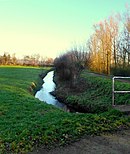 more pictures |
| Dorbach | above the Reinartzkehl riding stables in Friedrichswald | in the area of seven sources in the torrent |
 more pictures |
||
| Johannisbach | south of Hanbruch and at Gut Hasselholz | Paunell | Pottenmühle, Junkersmühle, Plattenbauchmühle, Schönforster Mühle, Sackmühle, Untere Pletschmühle | under the Aachener Peterstraße in the Pau |
 more pictures |
| Pau | in the Ronheider Berg area in the Aachen Forest | Klotzweider Bach, Kannegießerbach | Burned mill, Rosmühle, Brudermühle, Heppionsmühle | in the Rehmplatz area in the Wurm |
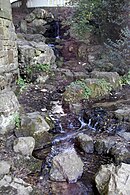 more pictures |
| Paunell | in the Ronheider Berg area in the Aachen Forest; Part of the Pau, which was diverted in artificial canals to supply the medieval city with water and energy. |
Grinding Mill Goethestrasse, Pulvermühle Mozartstrasse, Kupfermühle Karmeliterstrasse | in the Willy-Brandt-Platz area in the Johannisbach |
 common source pond of Pau and Paunell |
|
| Kannegießerbach | Near the Grundhaus Lütticher Straße | White mill | In the Hangeweiher area in the Pau |
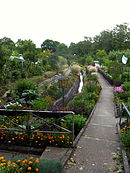
|
|
| Gillesbach | Steinebrück district | in the Brabantstraße area at the corner of Oppenhoffallee in the Wurm |
 more pictures |
||
| Beverbach | Augustinian Forest | Hitfeld receiving water, Hitfelder Bach, receiving water Waldfriedhof | Mill in the Heidbenden, Buschmühle, Grüntalsmühle, Krautmühle, Bevermühle, Kirberichshofer Mühlen, Upper and Lower Paper Mills, Fulling Mills | in the area of the crossing Brabantstraße-Luisenstraße in the Wurm |
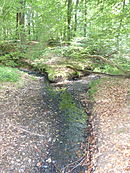 more pictures |
| Haarbach | in the Driescher Hof district of Aachen-Forst | Friend Bach, Brander Bach, Rödger Bach, | Harner Mühle , Nirmer Mühle , Scheidmühle , Kahlgrachtmühle , Welsche Mühle | in the district of hair in the worm |
 more pictures |
| Rödgerbach | in the Lützow barracks area | Ellerbach | Height of the sewage treatment plant from Eilendorf -Nirm to the Haarbach |
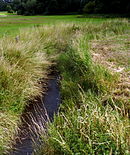
|
|
| In the | southeast of Raeren ( Belgium ) | Fobisbach, Bechheimer Bach, Rollefbach, Steinbach | Funny mill | southwest of Jülich into the Rur |
 more pictures |
| Iterbach | south of Raeren | Königsmühle, Gut Eisenhütte | in Kornelimünster in the Inde |
 more pictures |
|
| Rollefbach | Lichtenbusch , Oberforstbach , Schleckheim | Confluence of the Holzbach and Oberforstbacher Bach near Niederforstbach | on the southern outskirts of Aachen-Brand in the Inde |

|
Web links
- Documentary: Aachen brooks. The importance of the Aachen brooks for the development of industry in the Aachen area by Jannis Karayannakos and Klaus Krafft, 2018 film Aachen brooks on YouTube
- Water stationing map in ELWAS-WEB, electronic WAS-economic network system in NRW
- Water directory of the State Office for Nature, Environment and Consumer Protection NRW (LANUV)
- City of Aachen, links on the subject of water
- Biotope register of the State Office for Nature, Environment and Consumer Protection (LANUV) NRW
- Channels and stream disclosures
- Bach functions
- Aachen - the city of springs and fountains
Bach portraits on the website of the Ecology Center Aachen
- Bach portraits
- The worm
- The Haarbach
- The Johannisbach from the Aachen forest to the Kugelbrunnen - three kilometers of city history
- The Johannisbach - its underground course in the city center
- The jug-maker brook
- The tributaries to the hillside pond
- Wildbach - the "wild one" from Seffent
- The torrent in the Soers
Aachen environmental newsletters from the Ecology Center Aachen eV
- Aachen Environmental Circular No. 52–2003: The Wurm - historical course
- Aachener Umwelt-Rundbrief No. 56 - The torrent - the old mill locations
- Aachen Environmental Circular No. 61 - The Haarbach - Course and old mill locations
- Aachen Environmental Circular No. 63 - December 2008: Quo vadis, septem fontes?
- Aachener Umwelt-Rundbrief No. 65 - December 2009: Aachener Brooks
- Aachener Umwelt-Rundbrief No. 66 - June 2010 The sources of the Aachen brooks
- Aachen Environmental Circular No. 68 - July 2011: The Beverbach
Historical water use
- New insight into historical water use
- Mills, water rights and steam power
- Water calendar: "Aachen 2016, City of Water"
literature
- Petri a Beeck imperialium ecclesiarum in Aquis b. Mariae Canonici ad D. Adalbertum Praepositi: AQUISGRANUM sive historica Narratio de regiae SRJ et coronationis regum Rome. sedis Aquensis civitatis origine ac processu. Aachen 1620. (Reprint: 2010, ISBN 978-1-167-00972-3 ) Full-text digitized version of the Bavarian State Library and the University of Ghent in full text at books.google.de
- Peter Bertram: Early mill works. In: Gerhard Fehl (Ed.): With water and steam ... into the industrial age: contemporary witnesses of the early industrialization in the Belgian-German border region. Meyer & Meyer, Aachen 1991, ISBN 3-89124-103-8 , pp. 170-171.
- Luise Freiin von Coels von der Brügghen: The streams and mills in the Aachen empire and in the area of the imperial abbey of Burtscheid. In: Journal of the Aachen History Association. Volume 70, 1958, pp. 5-122.
- Josef Dahmen: The Aachen cloth industry. Your economic and social foundations. A theoretical investigation of the location factors for the economic practice of the Aachen cloth industry. Berlin, Leipzig, Vienna: White. 1930.
- Richard Pick: The Aachen brooks. In: Richard Pick: From Aachen's past - contributions to the history of the old imperial city. Aachen 1895, p. 384 ff.
- Christof Peter, Franz Meiers and others: Securing evidence - walks along the Aachen brooks. Library of the Burtscheid Society for Past and Present , Aachen 1983.
- Anke Schütt: Where water flows and bronze shimmers. Fountains and monuments in Aachen. Circular routes. 1st edition. Einhard, Aachen 2002, ISBN 3-936342-14-8 .
- Publications of the Ecology Center Aachen eV :
- Explore streams in Aachen. 4th revised edition. 1998.
- Living water - the thermal springs of Aachen and Burtscheid. 2000.
Footnotes
- ^ Aachen in the Roman Empire
- ↑ Albrecht Mann: Vicus aquensis , pp. 4–9.
- ↑ Overview of the Aachen brooks ( Memento from September 24, 2015 in the Internet Archive )
- ↑ Map of the Aachen brooks ( Memento from September 28, 2007 in the Internet Archive )
- ↑ Water from the Pau used to drive the mills
- ↑ Birgitta Hollmann: The torrent - the old mill locations. ( Memento from September 24, 2015 in the Internet Archive ) In: Aachener Umwelt-Rundbrief. # 56.
- ↑ Birgitta Hollmann: The Haarbach - course and old mill locations. ( Memento from September 24, 2015 in the Internet Archive ) In: Aachener Umwelt-Rundbrief. No. 61.
- ^ F. Mainz: The old forest - contributions to a history of the Aachen forest district. M. Olivier Verlag, Aachen 1985, p. 81 ff., Library of the Burtscheid Society for Past and Present.
- ↑ a b Luise Freiin von Coels von der Brügghen: The brooks and mills in the Aachen empire and in the area of the imperial abbey of Burtscheid. In: Journal of the Aachen History Association. Volume 70, 1958, pp. 5-122.
- ↑ Bruno Lerho : From old times, The Aachener Bachpolizei. In: Aachener Nachrichten. August 18, 1997.
- ↑ a b Channels and Bach disclosures ( Memento from September 24, 2015 in the Internet Archive )
- ↑ "Weiher was a breeding ground for malaria" , Aachener Zeitung May 15, 2008.
- ^ The work of a great Stolberger , Aachener Zeitung October 5, 2014.
